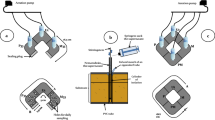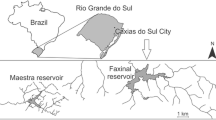Abstract
Although oligochaete worms naturally coexist with cladocerans in many shallow freshwater ponds and lakes, their influence on the latter is not well established. In this work we studied the effect of Aeolosoma sp. on the population growth of Alona rectangula, Ceriodaphnia dubia, Daphnia pulex, Macrothrix triserialis and Moina macrocopa. Population growth studies were conducted at one algal food density (1 × 106cells ml−1 of Chlorella vulgaris). The experimental design was similar for all five cladoceran species, where we used 100 ml capacity transparent jars containing 50 ml of EPA medium with the desired algal density and three replicates for each treatment. The test medium was changed daily and fresh algal food was added. The initial density of each of the cladoceran species in the population growth studies was 0.4 ind ml−1 while that of the worms 1.0 ind ml−1. Following inoculation, we estimated daily the number of cladocerans and the worms for duration of 21 days. Regardless of the presence of worms, Moina macrocopa and Macrothrix triserialis showed rapid population growth while A. rectangula took more than 2 weeks to reach peak abundances. With the exception of M. triserialis, all the other our cladoceran species declined in the presence of Aeolosoma sp. The lowest peak population density (about 1 ind ml−1) was observed for M. triserialisin controls. The remaining species had peak densities of about 3–5 ind ml−1. The rates of population increase per day varied from 0.03 to 0.19 depending on the cladoceran taxa and the treatment. In general we found that pelagic taxa were more adversely affected by the presence of the worms than were the littoral cladocerans.
Similar content being viewed by others
References
Anon, 1985. Methods of measuring the acute toxicity of effluents to freshwater and marine organisms. US Environment Protection Agency EPA/600/4-85/013.
Borowitzka, M. A. & L. J. Borowitzka, 1988. Micro-algal Biotechnology. Cambridge University Press, London, 480 pp.
Brinkhurst, R. O. & S. R. Gelder, 2001. Annelida: Oligochaeta, including Branchiobdellidae. In Thorp, J. H. & A. P. Covich (eds), Ecology and Classification of North American Freshwater Invertebrates, 2nd edn. Academic Press, New York: 431-463.
De Meester, L. & L. J. Weider, 1999. Depth selection behavior, fish kairomones, and the life histories of Daphnia hyalina X galeata hybrid clones. Limnology and Oceanography 44: 1248-1258.
Dodson, S. I. & D. G. Frey, 2001. Cladocera and other branchiopoda. In Thorp, J. H. & A. P. Covich (eds), Ecology and Classification of North American Freshwater Invertebrates. Academic Press, London, 850-914.
Dumont, H. J. & S. Negree, 2002. Introduction to the Class Branchiopode. Backuys, Leiden, 398 pp.
Hurtado-Bocanegra, M. D., S. Nandini & S. S. S. Sarma, 2002. Combined effects of food level and inoculation density on competition between Brachionus patulus (Rotifera)and the cladocerans Ceriodaphnia dubia and Moina macrocopa. Hydrobiologia 468: 13-22.
Krebs, C. J., 1985. Ecology: The Experimental Analysis of Distribution and Abundance. Harper &Row, New York, 800 pp.
Loose, C. J. & P. Dawidowicz, 1994. Trade-offs in diel vertical migration by zooplankton: the costs of predator avoidance. Ecology 75: 2255-2263.
Nandini, S., 2000. Responses of rotifers and cladocerans to Microcystis aeruginosa (Cyanophyceae): A demographic study. Aquatic Ecology 34: 227-242.
Nandini, S. & S. S. S. Sarma, 2000 Lifetable demography of four cladoceran species in relation to algal food (Chlorella vulgaris) density. Hydrobiologia 435: 117-126.
Nandini, S. & S. S. S. Sarma, 2003. Population growth of some genera of cladocerans (Cladocera)in relation to algal food (Chlorella vulgaris) levels. Hydrobiologia 491: 211-219.
Nandini, S., G. Muro-Cruz & S. S. S. Sarma, 2002. Competition between littoral cladocerans Macrothrix triserialis and Alona rectangula (Cladocera) in relation to algal food level and inoculation density. Acta Hydrochimica et Hydrobio logica 30: 16-23.
Pennak, R. W., 1989. Fresh-water Invertebrates of the United States: Protozoa to Mollusca. Wiley Publishers, New York, 628 pp.
Peters, R. H., 1993. A Critique for Ecology. Cambridge University Press. New York, 366 pp.
Romanovsky, Y. E., 1984. Individual growth rate as a measure of competitive advantages in cladoceran crustaceans. Internationale Revue der gesamtan Hydrobiologie 69: 613-632.
Saint-Jean, L., 1983. The zooplankton. Lake Chad. Monographiae Biologicae, pp 199-232.
Sarma, S. S. S., N. lyer & HJ. Dumont, 1996. Competitive interactions between herbivorous rotifers: importance of food concentration and initial population density. Hydrobiologia 331: 1-7.
Sarma, S. S. S., H. J. Dumont, S. Nandini, 2004. Interactions between the anomopod cladocerans Ceriodaphnia dubia, C. cornuta, Simocephalus vetulus and S. serrulatus, the aphanoneurid worn Aeolosoma sp., and the fish Skiffia lermae: predation or competition, or both? Hydrobiologia 526: 147-156.
Smirnov, N. N., 1992. The Macrothricidae of the World. Guides to the Identification of the Microinvertebrates of the Continental Waters of the World. SPB Acad. Publ., The Netherlands, 143 pp.
Sokal, R. R. & F. J. Rohlf, 2000. Biometry. W. H Freeman and Company, New York, 887 pp.
Tollrian, R. & C. D. Harvell (eds), 1998. The Ecology and Evolution of Inducible Defenses. Princeton University Press, Princeton, NJ: 383 pp.
Author information
Authors and Affiliations
Rights and permissions
About this article
Cite this article
Nandini, S., Sarma, S.S.S. Effect of Aeolosoma sp. (Aphanoneura: Aeolosomatidae) on the Population Dynamics of Selected Cladoceran Species. Hydrobiologia 526, 157–163 (2004). https://doi.org/10.1023/B:HYDR.0000041607.83808.67
Issue Date:
DOI: https://doi.org/10.1023/B:HYDR.0000041607.83808.67




